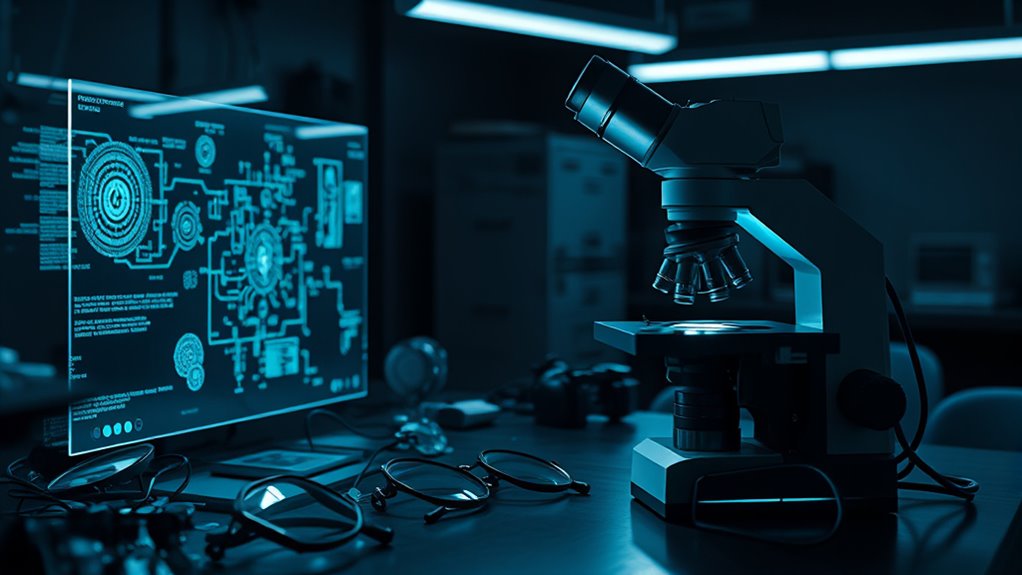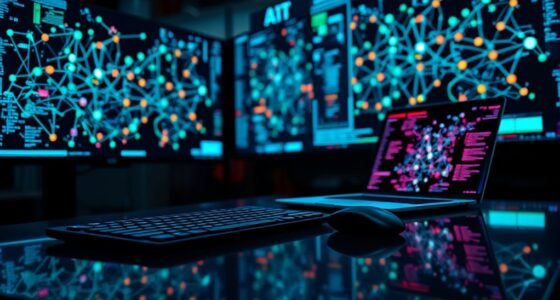In the ongoing arms race, you see watermark detection and forensics constantly evolving to stay ahead of those trying to remove or hide digital signatures. Advanced algorithms and machine learning help identify embedded watermarks even under heavy tampering, while forensic analysis traces unauthorized uses and manipulations. As adversaries develop new methods, you must keep up with innovations that make your content more secure. If you want to understand how these technologies adapt and improve, keep exploring the latest developments.
Key Takeaways
- The ongoing arms race drives the development of more robust watermarking and forensic detection techniques to counter increasingly sophisticated removal methods.
- Advanced algorithms leverage statistical, pattern recognition, and machine learning tools to enhance watermark resilience and detection accuracy.
- Forensic analysis plays a crucial role in tracing unauthorized distribution and identifying tampering or removal attempts of watermarks.
- Content creators and rights holders continuously innovate to stay ahead of adversaries attempting to bypass or obscure watermarks.
- Future trends focus on integrating cryptography and adaptive methods to strengthen digital rights management amid evolving threats.

Have you ever wondered how digital watermarks help identify and protect your multimedia content? When you create or share images, videos, or audio files, digital watermarks act like invisible signatures, embedding information directly into your files without altering their appearance or quality. These watermarks serve as a fingerprint, allowing content owners to verify ownership, track distribution, and combat piracy. They’re indispensable tools in a digital landscape where content theft and unauthorized use are constant threats. By embedding unique, often imperceptible data, watermarks enable you to prove your rights and take action against infringers, making them invaluable for artists, businesses, and media organizations alike.
Detecting these watermarks, however, isn’t always straightforward. Sophisticated algorithms analyze multimedia files to locate and extract embedded signals, even when they’re heavily distorted or tampered with. As a user, you rely on advanced detection systems that can identify watermarks amidst noise, compression artifacts, or deliberate attempts at removal. These systems often employ statistical analysis, pattern recognition, and machine learning techniques to distinguish genuine watermarks from false positives. The goal is to guarantee the watermark’s robustness, so it remains detectable under various conditions, yet unobtrusive enough not to affect the user experience or the content’s integrity.
Forensics plays a vital role in this ecosystem, helping you trace the origin or unauthorized distribution of your content. When a watermark is detected in an illicit copy, forensic methods analyze how it was manipulated or removed, uncovering clues about the infringer’s tactics. This process often involves comparing multiple copies, examining alterations, and using cryptographic techniques to verify authenticity. For you, this means that even if your content is illegally circulated, forensic analysis can help identify the source or the point of breach, strengthening your legal position. It’s a constant battle of innovation, with forensic experts developing new tools to counter increasingly sophisticated attacks.
As technology advances, an arms race emerges between watermarking techniques and those attempting to bypass them. Content creators and rights holders develop more resilient, adaptive watermarks, while adversaries craft methods to remove or obscure them. This ongoing tug-of-war pushes both sides toward innovation—improving detection algorithms, embedding more complex signals, and developing smarter forensic tools. For you, understanding this dynamic underscores the importance of staying ahead in digital rights management. The future will likely see even more robust watermarking systems and forensic methods, making it harder for unauthorized use while ensuring your legitimate content remains protected. Ultimately, this relentless evolution highlights the importance of continuous adaptation in safeguarding your multimedia assets in a rapidly changing digital world.
Frequently Asked Questions
How Do Watermark Detection Methods Adapt to Emerging Deepfake Technologies?
You can adapt watermark detection methods by integrating AI-driven algorithms that analyze subtle inconsistencies and artifacts unique to deepfakes. Using machine learning, you identify patterns that humans might miss, and update your systems regularly with new deepfake examples. Combining biometric analysis, metadata scrutiny, and temporal consistency checks helps improve accuracy. Staying ahead requires continuous research and collaboration, so you can fine-tune your detection to keep pace with evolving deepfake techniques.
What Are the Ethical Implications of Forensic Watermarking in Privacy Rights?
You should consider that forensic watermarking raises ethical concerns about privacy rights, as it can enable constant tracking and surveillance without individuals’ consent. While it helps verify content authenticity, you might worry about potential misuse, data collection, or erosion of anonymity. Balancing the benefits of combating misinformation with respecting personal privacy is essential, so you need transparent policies and safeguards to guarantee ethical implementation.
Can Watermarks Be Removed Without Damaging the Original Content?
Yes, watermarks can sometimes be removed without damaging the original content, but it’s tricky and depends on the watermark’s complexity. Skilled individuals might use advanced techniques like noise reduction or content-aware editing to eliminate watermarks, risking subtle alterations. You should know, though, that removing watermarks often crosses ethical lines and can compromise content integrity. Proceed with caution—such actions might have unintended consequences or legal repercussions.
How Do Legal Standards Vary Across Different Jurisdictions for Watermark Forensics?
Legal standards for watermark forensics vary widely across jurisdictions. In some regions, courts require clear evidence of tampering, while others accept more circumstantial proof. You need to understand local laws on digital evidence, intellectual property, and privacy. Always make certain your forensic methods comply with legal standards to avoid challenges or dismissal. Consulting local legal experts helps you navigate jurisdiction-specific requirements, making your watermark analysis more credible and admissible.
What Role Will Artificial Intelligence Play in Future Watermark Arms Races?
Artificial intelligence accelerates the arms race by enabling advanced watermarking techniques that are harder to detect or decode. You’ll see AI-driven tools swiftly outsmart traditional methods, prompting creators to continuously craft clever countermeasures. As AI amplifies the arms race, you’ll need to stay vigilant, adapt quickly, and leverage cutting-edge AI innovations yourself to stay ahead in this ongoing struggle for secure, subtle watermarking and effective forensic detection.
Conclusion
Just like a detective chasing clues in a high-stakes game, you’ll find that watermark detection and forensics are an ongoing arms race. When a hacker once bypassed a watermark system as easily as slipping through a locked door, it reminded me that technology constantly evolves. Staying ahead requires innovation and vigilance. Keep adapting, and you’ll be like a vigilant guardian, always one step ahead in this digital battlefield.








